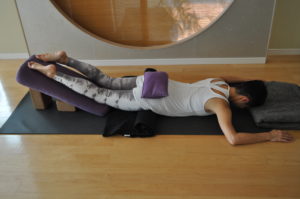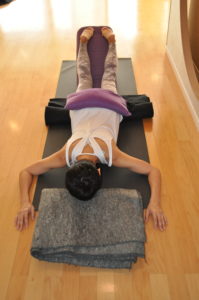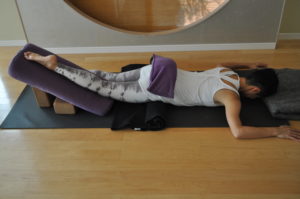
by Leza Lowitz
Surfboard pose is a wonderful way to gently release the sacrum and lower back, while relieving stiffness in the neck, upper back, and shoulders. Lying on the belly also allows us to let go of subtle gripping in the thighs, groins, pelvis, and belly. Further, it helps to release constriction in the psoas muscles, relieving tension in the abdomen and stimulating the digestive system and kidneys. Surfboard pose is recommended for those who feel anxious or overwhelmed, have trouble quieting the mind, or keeping their eyes closed.
I do this pose when I have an aching back, when my shoulders and neck are stiff, or when I just feel overwhelmed by the pace and demands of life and want to feel more grounded. It is also recommended for those with mild anxiety as it is a prone pose, which is calming and comforting.
Caution: Those with eye problems and lower back issues should avoid this pose. If your lower back begins to hurt in the pose, bend the knees and roll off the props, then slowly come out of the pose. If you have a pacemaker, it is recommended that you place an additional support under your chest and/or make an elbow rest for your head so there is no pressure on the device.
Finally, although prone poses (face down) can be helpful for people with anxiety, those recovering from trauma may find they feel unsafe. If this is true for you, skip this pose for now and practice a supine pose (on your back) instead, such as Reclined Cobbler’s pose or Empress pose. And for everyone, if any restorative pose feels unsafe to you instead of relaxing, it’s best to find something else to do.
Setting Up
Start by spreading a yoga mat on the floor. Towards the lower half of the mat, place a support—a block or stack of blankets folded into narrow rectangles— under your bolster. Now place the bolster or rolled-up pillow vertically on the support so the bolster is at a diagonal, like a slide. Fold another blanket in a square and roll up the top edge. Place that horizontally on the mat where your pelvis will go. Take another square blanket and place it at the end of the mat to rest your forehead on. You can also use a neck pillow or folded-up towel to support your forehead. If more support of softness is needed under your torso, place a blanket there.
To Come into the Pose
Sit with your knees bent in front of the bolster, then slide your legs onto the bolster, and place your pelvis on top of the rolled-up blanket. Bring your chest down so that it is on top of the mat, and place your forehead on top of the folded-up blanket. Bring your arms into cactus position. You will feel a slight arch in the lower back, such as in Sphinx or Cobra poses. Breathe deeply.
If your nose is feeling squashed, make an “elbow rest” by stacking your hands and place your forehead on your hands so your nose is not touching any surface.
Make sure you are evenly laid out, supported, and comfortable. Elongate the back of your neck. Allow your head to release toward the floor and let your shoulder blades draw towards one another. Allow your hips to sink down into the blanket and release—try to avoid letting your pelvis pop up. Feel your hip joints soften.
As your breath deepens and softens your back body, your front body drops into the embrace of the ground and props, helping to calm and soothe your mind and body and activate the parasympathetic nervous system (the relaxation response). The soft pressure at your belly and abdomen induces a grounding effect.
Variations
Place an additional blanket under your legs on top of the bolster if needed for support under the knees.
If it is more comfortable, place an extra pillow or rolled up blanket under your clavicle.
If you feel any strain or pressure in the lower back, do this pose one leg at a time, with one leg on the bolster and the other lengthening along the ground.

Place a rolled-up blanket or sandbag on your lower back for release and a feeling of “containment” and support.
Practicing the Pose
Sense all the places you feel your body making contact with the props and the ground. Take several slow, deep breaths to release your weight, melting into the support.
Bring your awareness to your back body. As you inhale, soften your lower back, hips, upper back, shoulder blades, shoulders, head, and neck. As you exhale, melt into the support, releasing earthward.
Notice the sensations in your body and any emotions that arise. Notice without judgement, holding them in loving awareness.
You can also try releasing tension, stress, anxiety, worry, and exhaustion on the exhalation and cultivating cultivate peace, self-love, and comfort on the inhalation.
Stay from 5-15 minutes as long as there is no discomfort. When you’re ready to come out, slowly take your time to lift yourself up enough with your hands to bend your knees, roll onto your right side, and enjoy a few quiet breaths before coming up slowly, head last.
You can read more about Leza’s writing at www.lezalowitz.com and about her yoga studio and classes at www.sunandmoon.jp.
Follow Yoga for Healthy Aging on Facebook ° To order Yoga for Healthy Aging: A Guide to Lifelong Well-Being, go to Amazon, Shambhala, Indie Bound or your local bookstore.


Another interesting post to try! Loving these ideas!